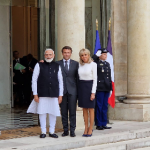Prime Minister Narendra Modi’s visit to France on May 4 is his fifth since 2015, and the 10th such high-level bilateral visit.
This time the exchange between the French and Indian leaders was especially significant. France, for instance, represented the European Union’s (EU) case on the potential India-EU Free Trade Agreement, and on the EU’s position on the Russia-Ukraine crisis. The strength and trust in the bilateral was evident in the difficult discussions of these two multilateral subjects, which were nonetheless addressed. Far easier was the bilateral-level exchange, as Paris and Delhi have a wide range of complementary and converging interests. Indeed, they have long been reliable partners, and friends in need – as recently as 2019 when the first French-built Rafale aircraft arrived in India. There are several key areas of cooperation that are underway – in defence, the blue economy, education, climate, energy, digitalisation and technical collaboration – that can be leveraged to deepen the bilateral.
In the immediate, there is geopolitics to navigate. Beyond the turbulence brought on by the Ukraine crisis, India and France both believe in maintaining strategic autonomy and have a shared understanding of global risks across geographies and domains. There is already a high-quality India-France political dialogue on defence, maritime, counter-terrorism, and the Indo-Pacific. The two countries are now forging ahead with cooperation on 21st century issues like digital, cyber, green energy, blue economy and ocean sciences and space. Both countries possess advanced skills and similar thinking in these areas and can enhance trade, investment and together rebuild disrupted supply chains.
They comprehend their respective dependencies well, especially in relation to China, Russia and the U.S. Here, India can play a significant diplomatic role to soften the tendency toward confrontation that is becoming ever more prevalent in the international system today. Both can work to insulate the Indo-Pacific from the worst consequences of current conflicts
Two areas of cooperation are particularly bright: energy and digital technology. France is a significant global power with expertise in both fields.
On digital technology, French companies have long been active in India, which is an important hub for their day-to-day activities as well as R&D and innovation. The French tech services multinational Atos, for instance, provides India with supercomputing hardware and quantum computing simulation software. A recent Track 1.5 Dialogue hosted jointly by think tanks Gateway House in Mumbai and Ifri in Paris, revealed the importance of Bangalore for the French economy, noting the large number of tech engineers from France who are located in the southern city. France also has a special tech visa for Indian engineers, enabling robust exchanges.
The digital cooperation is being stepped up in several ways. Macron and Modi agreed to join hands on cyber security and on building standards for public digital infrastructure. But more can be done in the areas of digital sovereignty, where India is a potential model for France with its use of open platforms and open source public goods like India Stack and MOSIP; collaboration in regulation, especially personal data empowerment and protection; health data and health tech.
France and India must now invest in preventing digital platforms from being weaponised, and avert threats to critical infrastructure. They must use their unique strengths – India in conceptualising and deploying large scale open source platforms, foundational IDs, IT services and fintech, and France in AI, cyber, quantum technologies, data empowerment and protection, to create the next-gen solutions and standards for the world.
This can also be done multilaterally, particularly in Francophone Africa and the Indo-Pacific, which are struggling to be independent of economically and politically costly Chinese and U.S. proprietary tech systems.
On energy, the case for green energy is growing stronger as soaring energy costs undermine purchasing power and industry competitiveness. Long years of underinvestment in traditional energy sources, specifically petroleum, is responsible for this. The current crisis is forcing Europe to reconsider or even reinvent its economic model and accelerate investment in low carbon alternatives like wind, solar PV, biomethane, heat pumps, nuclear and clean hydrogen.
India and France have shown they can work together in developing renewable energies, for instance through the International Solar Alliance. Both also recognise hydrogen as a serious alternative. More than energy, hydrogen matters for food security as it is used to make urea fertilizer. It can also be used as fuel for heavy trucks, which are 40% of India’s oil consumption. But India needs $1 trillion for a green hydrogen infrastructure and ecosystem, which includes massive investments in grids, where France has proven expertise, having developed part of the EU grid.
India has the market, France has the technology and capital, and the EU has the political will and incentives to drive the transition to green hydrogen. Major French multinationals such as Air Liquide, Engie and TotalEnergies are already pursuing hydrogen energy, and pilot projects with Indian partners can be planned. Modi and Macron have agreed to set up industrial partnerships to expand capacity. Active corporate intent is needed to explore further development. There are many takers for green energy in India if the cost of capital is lowered.
A progressive meeting between Modi and Macron has taken place. The strategic importance of the two countries to each other, and to the world, will soon be visible.
This article was first published in The Indian Express.
Manjeet Kripalani is the Co-founder and Executive Director of Gateway House, Mumbai.
John Seaman is Research Fellow, Center for Asian Studies, IFRI, Paris.


